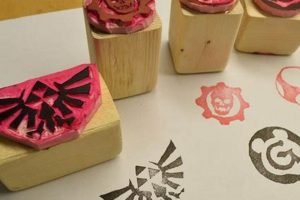A method involving the transfer of ink through a stenciled mesh screen onto a substrate, this practice allows individuals to create custom designs on various materials. The accessibility of this technique enables the reproduction of images, patterns, or text on items such as textiles, paper, and wood.
This form of printing offers a cost-effective and creatively fulfilling means to personalize objects, produce limited-edition artwork, or even establish small-scale businesses. Its historical significance lies in its evolution from traditional stencil techniques to a widely adopted industrial printing process. The ability to control the design and production process fosters artistic expression and entrepreneurial opportunities.
The following sections will delve into the tools and materials required, detail the step-by-step process, explore advanced techniques, and address common troubleshooting issues associated with this versatile printing method.
Enhancing Results in Stencil-Based Ink Transfer
Achieving optimal results in stencil-based ink transfer necessitates careful attention to several critical factors. Consistent execution of these guidelines will minimize errors and maximize the quality of the final printed product.
Tip 1: Mesh Tension Optimization: Maintaining proper tension on the screen mesh is crucial for consistent ink deposit. Insufficient tension results in blurred edges and uneven ink distribution. Employ a tension meter for precise measurements.
Tip 2: Emulsion Layer Thickness Control: The emulsion layer’s thickness directly affects the detail resolution and durability of the stencil. Apply a uniform layer using a calibrated coating trough and adhere to recommended drying times.
Tip 3: Exposure Time Calibration: Accurate exposure time is paramount for stencil integrity. Under-exposure leads to stencil breakdown during printing, while over-exposure results in loss of fine detail. Perform exposure tests with a step wedge to determine optimal settings.
Tip 4: Ink Viscosity Management: Ink viscosity impacts print quality and ease of application. Adjust viscosity using appropriate reducers or thickeners, considering the specific ink type and substrate material.
Tip 5: Squeegee Selection and Technique: Select a squeegee with appropriate durometer (hardness) and shape for the desired printing effect. Maintain consistent squeegee angle and pressure for uniform ink transfer.
Tip 6: Off-Contact Distance Regulation: Maintaining a slight off-contact distance between the screen and substrate prevents ink bleeding and improves print sharpness. Adjust the off-contact distance based on the substrate’s texture and thickness.
Tip 7: Proper Substrate Preparation: Ensure the substrate surface is clean, dry, and free from contaminants. Pretreating the substrate with appropriate primers or adhesives may be necessary for optimal ink adhesion.
Consistently implementing these recommendations will lead to enhanced print quality, improved stencil durability, and a reduction in waste materials. Mastering these techniques is essential for achieving professional-grade results.
The following sections will address common challenges and provide advanced techniques for those seeking to further refine their skill set in stencil-based ink transfer.
1. Screen Mesh Count
Screen mesh count is a critical parameter in stencil-based ink transfer, directly influencing the level of detail, ink deposit thickness, and overall print quality achievable. It is defined as the number of threads per linear inch (TPI) or centimeter within the screen fabric. Choosing the appropriate mesh count is essential for optimal results.
- Detail Resolution and Image Complexity
Higher mesh counts (e.g., 305 TPI or higher) are best suited for intricate designs and fine details. The finer weave allows for sharper edges and better reproduction of halftone images. Lower mesh counts (e.g., 86 TPI or lower) are appropriate for bold graphics and solid areas where high ink deposit is desired. Attempting to print detailed designs with a low mesh count will result in loss of detail and muddied images. A photograph with intricate details on a low mesh screen, for example, will be a smudge of its original self.
- Ink Viscosity and Flow Characteristics
The mesh count dictates the ease with which ink passes through the screen. High mesh counts require inks with lower viscosity to prevent clogging. Lower mesh counts can accommodate thicker, more viscous inks. Failure to match ink viscosity to mesh count can lead to poor ink transfer, uneven coverage, and screen blockage. For instance, using a thick textile ink with a high mesh count screen will result in a thin and patchy print.
- Substrate Texture and Ink Coverage
The texture of the substrate influences the optimal mesh count selection. Rough or porous surfaces, such as fabric or wood, often benefit from lower mesh counts to ensure adequate ink coverage and adhesion. Smooth surfaces, like paper or plastic, can accommodate higher mesh counts for greater detail resolution. Using a very high mesh count on a textured fabric could mean that ink transfer is insufficient to properly adhere to the fabric surface, resulting in a faded or incomplete design.
- Ink Deposit Thickness and Opacity
Lower mesh counts result in a thicker ink deposit, which is beneficial for achieving vibrant colors and opacity, especially on dark substrates. Higher mesh counts produce thinner ink deposits, which may be suitable for subtle designs or layering techniques. When printing white ink onto a black shirt, for example, a lower mesh count is usually preferred to ensure that the white ink is opaque and visible.
In conclusion, selection requires a careful balance between design complexity, ink properties, substrate characteristics, and desired print outcome. Consideration ensures a successful and high-quality final product. Without understanding screen mesh count, a user could spend hours trying to transfer an image only to experience constant problems. This foundational step significantly reduces frustration and optimizes resource utilization.
2. Emulsion Exposure Time
Emulsion exposure time represents a pivotal control variable within the screen printing process, influencing the stencil’s durability, detail resolution, and overall print quality. This timeframe determines the extent to which the light-sensitive emulsion hardens upon exposure to a UV light source. An improperly calibrated exposure time leads to either stencil breakdown during printing or loss of fine detail, directly affecting the final output. For example, under-exposure leaves the emulsion soft and prone to washing away, rendering the stencil unusable after only a few prints. Converse
ly, over-exposure can harden the emulsion to the point that it becomes difficult to wash out the unexposed areas, resulting in a stencil that lacks the intended design details.
The optimal exposure time is contingent upon several factors, including the type of emulsion used, the intensity and wavelength of the light source, and the thickness of the emulsion layer. Emulsions vary in their light sensitivity, necessitating different exposure durations for proper hardening. A low-wattage bulb will always take much longer to properly expose the emulsion on a screen. Similarly, the thickness of the emulsion layer impacts the amount of time required for the UV light to penetrate and fully cure the material. Without carefully managing exposure time, the creation of a reliable stencil remains elusive. In practice, this means that a user must meticulously calibrate the exposure process for each unique combination of emulsion, light source, and application technique.
In summation, understanding and accurately controlling the variable is essential for successful outcomes. Deviation from the correct timeframe negatively affects the fidelity of the design and the longevity of the stencil, ultimately impacting the quality and consistency of the final printed product. Recognizing the interdependence of factors impacting optimal exposure is crucial for addressing challenges in screen printing and achieving desired artistic or commercial goals. This knowledge provides a foundation for further exploration into advanced screen printing techniques and material choices.
3. Squeegee Pressure Control
Squeegee pressure control is a fundamental element within the screen printing process, influencing the quality of ink transfer and the clarity of the final printed image. Consistent and appropriate pressure is essential for achieving uniform ink distribution across the substrate.
- Impact on Ink Deposit Thickness
Varying pressure directly correlates with the amount of ink deposited onto the substrate. Insufficient pressure results in a thin, uneven ink layer, potentially leading to faded or incomplete images. Conversely, excessive pressure forces too much ink through the screen, causing blurring and loss of fine detail. A consistent moderate pressure is generally optimal. For example, a screen print with too little squeegee pressure may reveal the underlying substrate color, while too much pressure might cause the ink to bleed beyond the intended design boundaries.
- Influence on Edge Definition and Detail Resolution
Proper pressure maintains sharp edge definition and accurate reproduction of intricate designs. Consistent pressure ensures clean separation between printed and unprinted areas. Inadequate pressure can result in ragged edges and a loss of detail, particularly in fine lines and small text. Using too little pressure will cause the squeegee to glide across the mesh without making full contact, leaving a fuzzy and distorted image.
- Relationship with Ink Type and Substrate Material
Optimal pressure is dependent on the ink’s viscosity and the substrate’s texture. Thicker inks typically require more pressure to ensure proper transfer, while delicate substrates demand lighter pressure to prevent damage. Matching pressure to ink and substrate characteristics is vital. For example, applying high pressure when printing water-based ink on fabric may cause the ink to spread excessively, while using low pressure with plastisol ink on a smooth surface might result in poor adhesion.
- Effect on Print Consistency and Repeatability
Maintaining consistent pressure throughout the printing process ensures uniformity across multiple prints. Fluctuations in pressure lead to variations in ink deposit and image quality, making it challenging to achieve repeatable results. Implementing techniques for maintaining a steady squeegee angle and pressure is essential for consistent output. Without consistent pressure, achieving a uniform and professional-looking result becomes difficult to guarantee.
Therefore, mastery of pressure is critical for achieving high-quality screen prints. Consideration of ink properties and substrate characteristics, combined with the development of consistent technique, leads to optimal results. Implementing proper pressure balances the relationship between ink thickness, detail resolution, and achieving consistent results in a screen printing project.
4. Ink Viscosity Adjustment
Ink viscosity adjustment plays a critical role in achieving successful results within the context of stencil-based ink transfer. Ink viscosity refers to its resistance to flow; this property dictates how easily the ink passes through the screen mesh and onto the substrate. Proper adjustment ensures appropriate ink transfer, detail resolution, and overall print quality. The failure to address viscosity issues can lead to several problems, including clogged screens, uneven ink deposits, and blurred image details. In essence, it is a foundational aspect for success and the quality of the end product.
Different ink types exhibit varying viscosity characteristics, necessitating specific adjustment techniques. For instance, textile inks, commonly used for garment printing, typically require thinning with a reducer to achieve optimal flow through finer mesh screens. Conversely, certain specialty inks may need thickening to prevent excessive bleeding on porous substrates. When creating graphics for a t-shirt with plastisol ink, one may need to adjust the viscosity based on temperature, as plastisol can thicken in cooler environments, requiring the addition of a reducer. In contrast, a solvent-based ink for printing on plastic may need a thickener to prevent it from running and blurring the image. The proper use of viscosity adjusters enables the creation of designs with clear lines and consistent color saturation.
In summary, precise ink viscosity adjustment is essential. Factors such as ink type, substrate material, and desired print outcome dictate the appropriate viscosity. Proper adjustments ensure smooth ink transfer and enhance image resolution. Addressing potential difficulties linked to this parameter is vital for quality and efficiency, linking directly to stencil based transfer outcomes.
5. Substrate Surface Prep
Substrate surface preparation constitutes a critical preliminary stage in the screen printing process. Effective preparation ensures optimal ink adhesion, image clarity, and overall print durability, directly influencing the final product’s quality.
- Cleaning and Degreasing
The removal of surface contaminants, such as dust, oils, and fingerprints, is paramount. These substances impede proper ink bonding, potentially leading to peeling, flaking, or uneven coverage. Solvents or specialized cleaning solutions are employed to degrease surfaces before printing. A textile substrate, for instance, may require pre-washing to eliminate sizing agents or manufacturing residues that could interfere with ink adhesion.
- Surface Smoothing and Leveling
Uneven or rough surfaces can comprom
ise ink transfer and detail resolution. Smoothing techniques, such as sanding or filling, are applied to create a uniform printing surface. On wooden substrates, sanding removes imperfections and provides a consistent texture for optimal ink adherence. Such procedures enhance the visual clarity and longevity of the printed design. - Pre-Treatment Application
Specific substrates benefit from pre-treatment with primers or coatings to improve ink adhesion and prevent bleeding. These treatments create a receptive surface for the ink, enhancing its bonding properties. Textiles often undergo pre-treatment to prevent ink absorption into the fibers, resulting in sharper image definition. Pre-treatment optimizes ink performance, especially on challenging substrates.
- Drying and Curing
Following cleaning or pre-treatment, thorough drying is essential to remove residual moisture that could interfere with the printing process. Moisture can dilute the ink or prevent proper adhesion, leading to print defects. Curing processes, such as heat setting, are often employed after printing to permanently bond the ink to the substrate. A properly cured print exhibits increased resistance to washing, abrasion, and fading.
Neglecting substrate surface preparation undermines the entire screen printing process. Thorough preparation ensures the ink adheres effectively, resulting in a high-quality, durable print. Attention to these details is indispensable for successful screen printing outcomes, regardless of the scale or complexity of the project.
6. Design Stencil Accuracy
Accuracy in design stencils is paramount for achieving high-quality results in stencil-based ink transfer projects. The stencil serves as the template through which ink is applied, making its precision directly proportional to the fidelity of the final printed image.
- Resolution of Fine Details
The stencil’s ability to reproduce fine lines, intricate patterns, and small text directly determines the level of detail captured in the print. Inaccurate stencils result in blurred edges, missing elements, and a loss of overall image clarity. If a design requires the reproduction of a complex logo or a detailed illustration, even minor stencil inaccuracies can significantly degrade the final output.
- Registration for Multi-Color Prints
In multi-color printing, precise stencil alignment is essential for achieving accurate color registration. Misaligned stencils lead to overlapping colors, gaps between elements, and a distorted final image. The creation of multi-colored graphics demands meticulous stencil production and alignment to ensure that each color layer is accurately positioned relative to the others. For example, consider a three-color design with red, blue, and yellow elements; inaccurate stencils will cause these colors to bleed into each other or leave unsightly gaps.
- Consistency Across Multiple Prints
A well-defined stencil ensures consistent results across numerous prints. Stencil inaccuracies can lead to variations in image size, shape, and placement, making it difficult to produce a uniform batch of prints. When producing a series of identical prints, minor differences in stencil accuracy can compound over time, resulting in significant discrepancies between individual items.
- Durability and Longevity of the Stencil
The method used to create a stencil, including the design accuracy, directly affects its durability and lifespan. Inaccuracies introduced during the creation process can weaken the stencil, causing it to degrade or break down prematurely during printing. The use of improper techniques, such as an overexposed emulsion in screen printing, can compromise the structural integrity of the stencil, leading to inconsistent print results and a reduced lifespan.
Achieving accurate stencils necessitates careful attention to design preparation, stencil creation techniques, and alignment procedures. While digital design tools and precise cutting methods contribute to stencil accuracy, vigilant execution throughout the entire process is crucial for maximizing print quality and consistency.
7. Registration Alignment Precision
Registration alignment precision constitutes a critical factor in the successful execution of multi-color projects. It dictates the accuracy with which successive layers of ink are applied, directly impacting the clarity and visual fidelity of the final image. Inaccuracies in alignment result in misregistration, characterized by overlapping colors, unwanted gaps, and a generally blurred or distorted appearance. The impact of misregistration is particularly pronounced in complex designs featuring fine details or intricate color combinations. The root cause of misregistration can often be traced back to improperly prepared stencils, imprecise screen setup, or inconsistent printing techniques. The effects of misregistration can range from subtle imperfections noticeable only upon close inspection to gross distortions that render the print unusable.
Within the context of stencil-based ink transfer, the implementation of precise registration techniques is paramount. Various methods can be employed to achieve the necessary level of accuracy, ranging from simple manual alignment using registration marks to sophisticated mechanical systems. Manual methods typically involve visually aligning the different color layers based on printed registration marks placed outside the image area. While these methods can be effective for simpler designs, they are prone to human error and may not be suitable for complex graphics. Mechanical systems, such as micro-registration presses, offer a higher degree of precision by allowing for fine adjustments to the screen position. By offering increased control, these systems minimize the potential for misregistration and enable the production of highly detailed and accurately aligned prints. This is particularly important when reproducing complex artwork or graphics.
In conclusion, precise control over the alignment of successive color layers is essential for achieving professional-quality results in multi-color stencil based projects. The implementation of effective registration techniques, whether manual or mechanical, minimizes the risk of misregistration and ensures accurate reproduction of the intended design. Overcoming the challenges associated with registration requires meticulous attention to detail throughout the entire process, from stencil creation to printing. A deep understanding of alignment principles enables informed decision-making, enhancing the fidelity and impact of the printed artwork.
Frequently Asked Questions About DIY Silk Screen Printing
The following questions address common concerns and misconceptions regarding undertaking screen printing projects independently. These answers provide essential information for achieving successful outcomes.
Question 1: What is the minimum equipment investment required to begin this printing?
Initial investment varies based on the scale and complexity of planned projects. A basic setup necessitates a screen, squeegee, ink, emulsion, exposure unit (or alternative light source), and a washout booth or similar facility. The specific cost depends on the quality and size of the e
quipment chosen. While starter kits are available, individual component selection allows for greater customization and potentially cost savings.
Question 2: What types of designs are suitable for creating on my own?
Suitable designs range from simple, bold graphics to more intricate patterns. Complexity is constrained by the screen mesh count and the user’s skill level. Fine details and halftones require higher mesh counts and greater precision. Starting with simpler designs is recommended to develop proficiency before attempting more complex projects.
Question 3: What is the expected lifespan of a screen stencil?
Stencil lifespan depends on the emulsion type, exposure accuracy, ink type, and printing volume. Proper exposure and post-exposure hardening enhance durability. A well-maintained stencil can produce hundreds or even thousands of prints. Harsh solvents and abrasive cleaning practices shorten stencil life.
Question 4: How does one prevent ink from bleeding or blurring during the printing process?
Ink bleed and blur are often caused by excessive ink application, improper squeegee technique, or insufficient off-contact distance. Using the correct squeegee angle and pressure, selecting appropriate ink viscosity, and ensuring proper screen tension mitigate these issues. Substrate preparation is also crucial for preventing ink absorption and bleed.
Question 5: How is proper registration achieved for multi-colored designs?
Accurate registration requires precise stencil alignment and a reliable registration system. Registration marks are added to the design and used as visual guides for aligning each color layer. Multi-station printing presses or registration jigs facilitate precise and repeatable alignment. Consistent printing technique is essential for maintaining registration throughout the print run.
Question 6: What are the common troubleshooting steps when experiencing difficulties?
Common problems include stencil breakdown, ink clogging, and image distortion. Stencil breakdown is often caused by underexposure. Ink clogging can be resolved by thinning the ink or using a higher mesh count screen. Image distortion is typically attributed to improper squeegee technique or screen tension.
This FAQ provides essential guidance for those beginning or refining their skill set. Continued practice and experimentation are key to achieving consistent and high-quality results.
The subsequent section will delve into advanced techniques, materials and tips for optimizing the independent project experience.
Concluding Perspectives on DIY Silk Screen Printing
The exploration of “diy silk screen printing” reveals a multifaceted process demanding meticulous attention to detail. From substrate preparation and design accuracy to precise squeegee control and ink viscosity management, proficiency in these areas is paramount for consistent, high-quality results. Neglecting even one element can compromise the final output.
Mastery of this craft represents a pathway to creative expression and small-scale production. It demands diligent study, persistent practice, and a commitment to understanding the interplay between materials, techniques, and equipment. The rewards extend beyond mere reproduction; they encompass artistic fulfillment and the potential for entrepreneurial endeavors.







